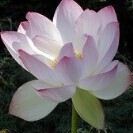-
Posts
934 -
Joined
-
Days Won
1
Content Type
Profiles
Forums
Events
Store
Downloads
Gallery
Everything posted by Franco
-
Insight, a professional restorer would use both mechanical and chemical treatments depending upon what is found. This, in order to ensure the surface is stripped absolutely clean. Otherwise, there could be failure in the re-patination process resulting in an ununiformed finish. One shakudo tsuba I had professionally restored took five (tedious, careful, time consuming) mechanical cleanings before being chemically prepared for re-patination. Even then the success of the re-patination will depend upon the quality of the shakudo. Which to some extent will be an unknown factor. Eventually, the quality of the shakudo will become apparent in the final result. On an excellent shakudo tsuba the finish will continue to re-patinate and improve, even dramatically, over time. With this wave tsuba, not only is there the body to restore but the rim needs attention, too. Then there is the question of what to do about all of the silver? and/or gold? drops that are missing? Value? Worth restoring? Kantei gives an answer. Good luck.
-
For sword polishing; Shigekazu "Jimmy" Hayashi (CA), Woody Hall (NV), Ted Tenold (MT), Takeo Seki (BC, Canada) . Habaki; Brian Tschernega (WA), John Tirado (PA) . Shirisaya/Saya/Tsuka; Brian Tschernega (WA), John Tirado (PA) . Tsuba; Brian Tschernega (WA) . Others? Generally speaking, for a nihonto being considered for polish/restoration, it is advisable that the blade at minimum meet the following NBTHK level requirements; https://nihontocraft.com/2015_NBTHK_Nionto_Tosogu_Shinsa_Standards.html . There are lots of previous discussions about most or all of the above artisans/topics/subjects to "search" on this website. Take your time. Desire is the cause of suffering.
-

SOME THOUGHTS ON BEGINNING THE COLLECTION OF TSUBA by Arnold Frenzel
Franco replied to Spartancrest's topic in Tosogu
https://www.jmnspecialties.com/downloads/sds/2350-varsol-sds/file -
Not polished down much. Certainly not what might be expected of an earlier Koto period sword. At this point my thought is a Shinshinto copy. Thank you for the additional information and images.
-
One more opinion, Shape suggests a Muromachi period sword. The question then becomes; is it truly a Muromachi period sword or an elaborate Shinshinto copy? What is the kasane at the widest point of the nakago vs at the mune-machi? What does the ko-shinogi look like from above? To my eye the ji-tetsu looks more Shinshinto as does the nakago patina vs Koto. "Too good for Kamakura." Hmm.
-
Rereading entire thread again.
-
Never mind.
-
Kantei: Time period ? ______ , Tradition? _____ , School ? _____ , Smith ? ______
-
Indeed, AFU translations as well as other translated publications do have mistranslations. And it worked in both directions where somebody's Japanese wasn't quite right or somebody's English wasn't quite right, ending with something getting lost in translation. That, on top of the fact that the study of nihonto is difficult to begin with and translators are sometimes not advanced in their knowledge of nihonto. This is one reason why it is essential to double and even triple check your findings with multiple sources. p.s. this lesson of mistranslations I learned the hard way when it was pointed out by non other than Han Bing Siong in response to a JSS article I had written. A most humbling early experience that taught me to make sure that all the facts were correct, as well as the importance of having a good nihonto library being invaluable.
-

Nihontocraft.com (Danny Massey) Legitimate?
Franco replied to Barrett Hiebert's topic in Auctions and Online Sales or Sellers
Another vote of confidence for Danny Massey at Nihontocraft.com being legitimate and reliable. Regards, Franco -
https://www.militaria.co.za/nmb/topic/8954-smiths-database-hawleysnihontoclubsho-shin-question/#findComment-90492 Btw, if memory serves this unlisted sword smith's sword received a well deserved TH origami. https://www.militaria.co.za/nmb/topic/8954-smiths-database-hawleysnihontoclubsho-shin-question/#findComment-90513 "The sword confirms the mei and not the other way around!"
-
Memory fades some, however, at some point there was a highspeed film of testing of a sword (Shinsakuto) on a Kabuto. One of the most fascinating details watching that film was seeing the sword actually flexing back on itself without breaking. The amount of distortion was nothing short of incredible to watch and none of it could be seen without the help of the highspeed film by the naked eye. What also came to light is what Eric is talking about here. After watching that film it became evident that the habaki played a critical role. If the habaki had not been made from a "giving shock absorbing material" like a copper, silver, or gold, there would have been some kind of catastrophic failure somewhere along the line from the immense transfer of energy. It often made me wonder if that was the reason that they stopped making iron habaki long ago. I'm almost certain that that filmed event was brought to our attention here on NMB. I know that I would love to watch it again if someone could bring up that information and link again?
-
Hello, For professional restoration of tsuba/tosogu and for other Japanese Sword Furniture services, highly recommend Brian Tschernega (search/google Brian Tschernega Washington for contact information).
-
fyi, https://www.aoijapan...22/F22509paper-1.jpg
-

This triggers my spidey senses
Franco replied to Lewis B's topic in General Nihonto Related Discussion
Appreciate bringing this sword to our attention, and for the follow up comment/explanation/link. Grazie -
Wonderful piece, most enjoyable! Tsuba finds the owner. Thank you for sharing. Auguri,
-
Brian Tschernega. I don't know what his turn around time is.
-

Would you knowingly buy a gimei blade?
Franco replied to a topic in General Nihonto Related Discussion
The Japanese write that 'Kantei is the foundation for Japanese sword appreciation.' They are correct in every sense. 'Forgive them for they know not what they do.' Principles.pdf https://www.pbs.org/...hailand/buddhism.htm





